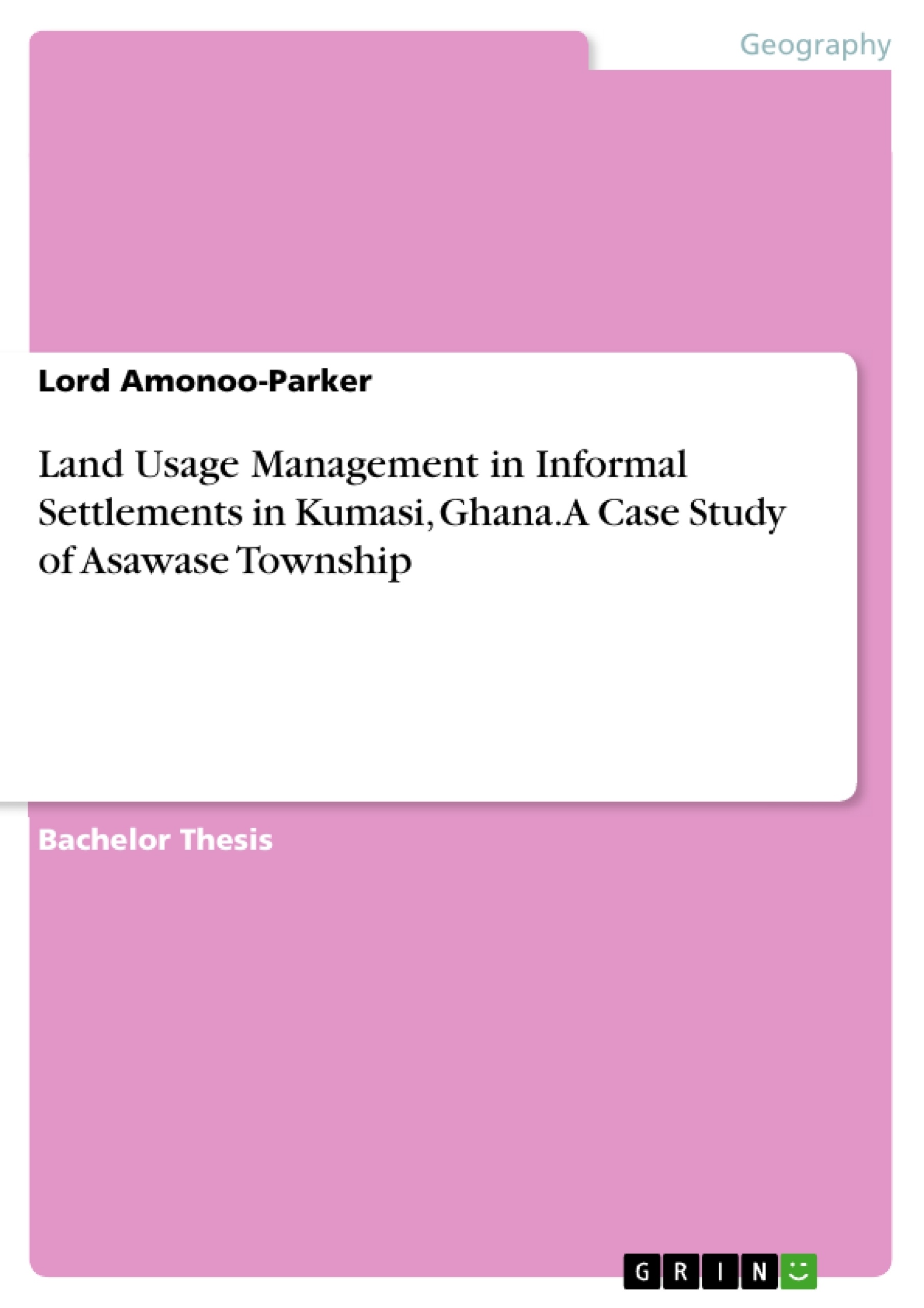The high rate of urbanization and fast growing population of cities have impacted on land management. The main objective of this study which focused on Asawase being the first estate that was built in Kumasi was to know how land is managed in informal settlements. The study analyzed how land can be effectively managed in Asawase, challenges of land management and also the legal and institutional arrangements backing management of land and to come out with recommendation on how land can be managed effectively in Kumasi., Ghana
The study employed the cross sectional research design in which the case study method was used. The research made use of the participatory approach in order to have diverse views on the research topi.The research adopted the use of questionnaires and interviews to collect data from slum dwellers and institutions in charge of managing land within Asawase such as Town and Country Planning Department(TCPD), Lands Commission(LC), Asokore Mampong Municipal Assembly (AMMA).
From the study, it was observed that, the conditions in Asawase had deteriorated considerably leading to poor sanitation, substandard of housing, lack of basic services and facilities and low generating income activities. It was further established that, the institutions in charge of managing land face a lot of challenges in undertaking their duties, some challenges are, political influence, delay in the release of funds, failure in reviewing plans and inadequate logistics, land litigation and disputes were also major challenges in the managing of land in Asawase.
Efficient land administration in urban areas could promote development of communities and enhance socioeconomic growth. Lastly, human resource and logistics should be adequate to make land service delivery efficient and make clients comfortable in their transactions with the institutions.
Index
ABSTRACT
CHAPTER ONE
INTRODUCTION
1.1 General Introduction
1.2 Problem Statement
1.3 Research Questions
1.4 Research Objectives
1.5 Brief Research Methodology
1.6 Organization of Study
1.7 Significance of the study
CHAPTER TWO
CONCEPT OF INFORMAL SETTLEMENTS
2.1 Introduction
2.2 Definition of Informal settlements
2.3 History of Informal settlements
2.4 Types of Informal settlements
2.4.1 Squatter Settlements
2.4.2 Illegal Subdivision
2.4.3 Substandard inner-housing
2.4.4 Settlement for vulnerable groups of refugees
2.4.5 Types of informal settlements in Ghana
2.5 Causes and Effects of Informal settlements
2.5.1 Causes of Informal settlements
2.5.2 Effects of Informal settlements
2.6 Addressing the Informal settlements
2.6.1 Laissez-faire approach
2.6.2 Upgrading Strategies
2.6.3 Urban land management and tenure
2.7 Institution responsible for management of land in Ghana
2.7.1 Municipal, Metropolitan and District Assemblies (MMDAs)
2.7.2 Land Registration Division
2.7.3 Land Commission (LC)
2.7.4 Town and Country Planning Department (TCPD)
2.8 Legal Framework of Land Administration in Ghana
2.8.1 Town and Country Planning Ordinance 1945
2.8.2 State Lands Act 1962(Act 125)
2.8.3 Lands Commission Act, 2008 (Act 767)
2.8.4 Building Regulations LI 1630
2.9 Summary of Lesson Learnt
CHAPTER THREE
PROFILE OF STUDY AREA AND RESEARCH METHODOLOGY
3.1 Introduction
3.2 Profile of Kumasi Metropolis
3.2.1 History of study Area
3.2.2 Location and Size
3.2.3 Population
3.2.4 Administration and Governance
3.2.5 Asawase in Context
3.3 Research Design
3.4 Categories of Data
3.5 Selection of Study Area
3.6 Sampling Technique
3.6. 1 Sample Frame and Sample Size Determination
3.7 Data Analysis and Presentation
3.8 Summary
CHAPTER FOUR
PRESENTATION AND ANALYSIS OF SOCIO-ECONOMIC AND ENVIRONMENTAL DATA
4.1 Introduction
4.2 Characteristics of Respondents
4.2.1 Ethnic Composition
4.2.2 Migration Study
4.2.3 Educational Status and Background
4.2.4 Employment Status
4.3 Housing Conditions and Physical Characteristics
4.3.1 Drainage Patterns
4.3.2 Housing
4.4 Land Operations
4.4.1 Security of tenure
4.4.2 Land Ownership and Land Use
4.4.3 Building/Development Permit Acquisition Process
4.5 Land Management Practices and Challenges
4.5.1 Land Registration.
4.5.2 Conformation of Physical Development to Plans
4.5.3 Adhering to planning rules and regulations
4.5.4 Land Dispute Resolution
4.5.5 Land Management Challenges
4.6 Chapter Summary
CHAPTER FIVE
SUMMARY OF FINIDINGS, RECOMMENDATIONS AND CONCLUSION
5.1 Introduction
5.2 Summary of Findings
5.3 Recommendations
5.4 Conclusion
REFERENCES
- Citation du texte
- Lord Amonoo-Parker (Auteur), 2017, Land Usage Management in Informal Settlements in Kumasi, Ghana. A Case Study of Asawase Township, Munich, GRIN Verlag, https://www.grin.com/document/540377
-

-

-

-
Téléchargez vos propres textes! Gagnez de l'argent et un iPhone X. -

-
Téléchargez vos propres textes! Gagnez de l'argent et un iPhone X. -

-
Téléchargez vos propres textes! Gagnez de l'argent et un iPhone X. -

-
Téléchargez vos propres textes! Gagnez de l'argent et un iPhone X. -

-
Téléchargez vos propres textes! Gagnez de l'argent et un iPhone X. -

-
Téléchargez vos propres textes! Gagnez de l'argent et un iPhone X. -

-
Téléchargez vos propres textes! Gagnez de l'argent et un iPhone X. -

-
Téléchargez vos propres textes! Gagnez de l'argent et un iPhone X. -

-
Téléchargez vos propres textes! Gagnez de l'argent et un iPhone X. -

-
Téléchargez vos propres textes! Gagnez de l'argent et un iPhone X. -

-
Téléchargez vos propres textes! Gagnez de l'argent et un iPhone X. -

-
Téléchargez vos propres textes! Gagnez de l'argent et un iPhone X.

